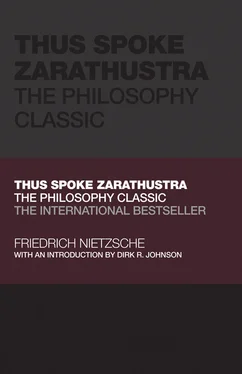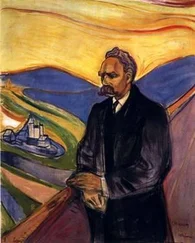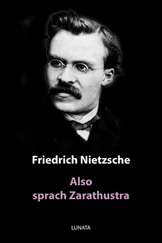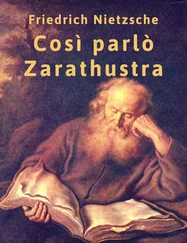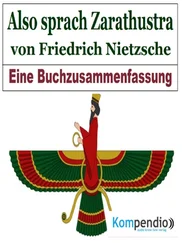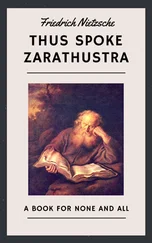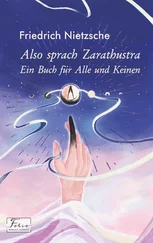Friedrich Nietzsche - Thus Spoke Zarathustra
Здесь есть возможность читать онлайн «Friedrich Nietzsche - Thus Spoke Zarathustra» — ознакомительный отрывок электронной книги совершенно бесплатно, а после прочтения отрывка купить полную версию. В некоторых случаях можно слушать аудио, скачать через торрент в формате fb2 и присутствует краткое содержание. Жанр: unrecognised, на английском языке. Описание произведения, (предисловие) а так же отзывы посетителей доступны на портале библиотеки ЛибКат.
- Название:Thus Spoke Zarathustra
- Автор:
- Жанр:
- Год:неизвестен
- ISBN:нет данных
- Рейтинг книги:5 / 5. Голосов: 1
-
Избранное:Добавить в избранное
- Отзывы:
-
Ваша оценка:
- 100
- 1
- 2
- 3
- 4
- 5
Thus Spoke Zarathustra: краткое содержание, описание и аннотация
Предлагаем к чтению аннотацию, описание, краткое содержание или предисловие (зависит от того, что написал сам автор книги «Thus Spoke Zarathustra»). Если вы не нашли необходимую информацию о книге — напишите в комментариях, мы постараемся отыскать её.
Thus Spoke Zarathustra: A Philosophy Classic, Thus Spoke Zarathustra: A Philosophy Classic
Thus Spoke Zarathustra — читать онлайн ознакомительный отрывок
Ниже представлен текст книги, разбитый по страницам. Система сохранения места последней прочитанной страницы, позволяет с удобством читать онлайн бесплатно книгу «Thus Spoke Zarathustra», без необходимости каждый раз заново искать на чём Вы остановились. Поставьте закладку, и сможете в любой момент перейти на страницу, на которой закончили чтение.
Интервал:
Закладка:
In February 1885, Nietzsche announced to a friend that he had completed a fourth (and final) part. Unlike the other three, he self‐published the final part. It was printed in a limited run of just forty‐five copies, and he distributed nine of them to select friends in April 1885. It is unclear what happened to the remaining stock.
All four parts of Zarathustra are today printed together as a single volume, and there is a unity that underlies them. But it is important to keep in mind that the fourth part came as a later addition not intended for the public, while the first three published parts represented a finished whole.
THUS SPOKE ZARATHUSTRA – OUTLINE
Zarathustra opens with a prologue in ten sections that sets the stage for its narrative. It introduces the protagonist – a man who has lived ten years alone in the mountains and now wants to descend to impart his wisdom to the people (Prologue 1).
Arriving as a prophet in a town, Zarathustra presents the ideal of the Übermensch to a crowd on a marketplace (Prologue 3). This higher being will transcend our present conception of man and will become the new meaning of the earth. He will be as superior to our current man as man now is in relation to the ape. (In English, Übermensch is variously translated as “Superman,” “Overman, “Uberman,” “Superhuman,” or “Overhuman.”)
Zarathustra then contrasts his vision of the Übermensch with the reality of the “last” man (Prologue 5). This last man shuns risk and seeks only comfort and conformity. He is like a flea that has overrun the earth with his mediocrity. Despite Zarathustra's disgust with the vision of the last man, the people in the town end by mocking his ideal and clamoring for the last man instead.
Nietzsche then inserts a dramatic interlude with a tightrope walker. He is there to offer the raucous crowd some entertainment (Prologue 6). While crossing over to the other side, the tightrope walker is pushed off by a scheming jester and falls to his death. The crowd is indifferent, but Zarathustra is moved by his plight. Fearful of the mood in the town, he sneaks out at night and buries the body (Prologue 8). Though the tightrope walker was scorned by the crowd, Zarathustra considers him a soulmate who made a vocation out of danger.
The next morning, Zarathustra has a sudden insight. He will no longer preach to the crowd but will seek solitary companions to lure away from the masses. These individuals will become his future target audience (Prologue 9). Zarathustra now embarks on a journey to find sensitive, alienated souls receptive to his superhuman ideal (Prologue 10).
In the space of ten short sections, Zarathustra has undergone a major pivot. No longer a message for humankind, the ideal of the Übermensch has now been narrowed down to a secret promise for a select few.
PART ONE
Part Oneis made up of 22 speeches or discourses. There is little dramatic action. Rather, Zarathustra declares in grandiose terms his views on various topics – friendship, the modern state, war, women, suicide, chastity, the scholarly life, and so on.
Most of these speeches do not suggest any correctives or concrete alternatives but critique aspects of modern society. There is a chord of cynicism in Zarathustra's words, reflective of someone who has suffered from life, but there is also deep longing.
In Part One, Nietzsche recapitulates many perspectives from his previous works. It is the end product of his free‐thinking middle years, where he had systematically unmasked the ideals of society. Nietzsche bundles these insights and themes into the separate sections of the text. However, they reveal a common undercurrent: skepticism towards all ideals upheld by modern society.
At the conclusion of Part One, Zarathustra departs from his followers. He enjoins them to forget him and go their own way. It is a curious ending. He has lured solitary individuals away from the masses – and mass thinking – but then offers them nothing concrete to embrace. His original vision of a transcendent human type remains diffuse and undefined.
PART TWO
In Part TwoZarathustra decides to return to his followers. Still animated by his superhuman ideal, he resumes with his speeches critical of society.
But Nietzsche now inserts more introspective sections. They hint at a deeper sense of melancholy and reveal a more human, relatable side to Zarathustra. He loses his prophetic aura and certitude and confronts a lingering spirit of heaviness and gravity.
THE THREE SONGS
In the midway point of Part Two, there are the three “Song” sections: “The Night Song,” “The Dance Song,” and “The Grave Song.” In “The Night Song,” Zarathustra compares his yearning soul to a gushing night time fountain. He transfigures the pain of his solitude into a poem of exquisite beauty. Zarathustra revels in his own independence but remains cut off from the world around him.
The section initiates a transition. While Zarathustra first sought converts to the Übermensch , he now retreats into himself and finds solace in an unfulfilled yearning.
This mood continues and deepens in “The Dance Song.” Zarathustra encounters a group of girls frolicking in a woodland enclave. Though enchanted, his mood darkens, and he complains about a spirit of gravity. Two (metaphoric) women vie for his attention: Life and Wisdom. While Life is seductive and tries to pull him back into life, Wisdom beckons him to uncover life's mysteries.
In “The Grave Song,” Zarathustra lashes out at his enemies. They are the figures in his childhood that ruined his immediacy and naiveté towards life by (dis)orienting him to false (Christian) ideals. They sullied his spontaneous childlike affirmation of life.
This deep‐rooted suspicion toward life stands at the core of his personal spirit of gravity. It always threatens to pull Zarathustra away from life and towards false, otherworldly ideals, and it triggers a residual disgust with the world.
THE SOOTHSAYER AND THE STILLEST HOUR
In “The Soothsayer,” Zarathustra relates a mysterious dream to his disciples. In it, a black coffin bursts open and spews forth “a thousand caricatures of children, angels, owls, fools, and child‐sized butterflies.”
The dream reveals an underlying psychic tension and a gnawing ambivalence. Whereas he first descended to humankind in the role of self‐assured prophet, he must now acknowledge the graves of his past that impede his way to the goal of affirmation of life as it is.
In the closing section of Part Two, entitled “The Stillest Hour,” Zarathustra relates how a night time voice whispers to him to confront what he already knows. In prior sections, he had revealed greater vulnerability and signs of emotional turmoil. But he had not garnered the strength or courage to excavate the deeper meanings of his moods.
PART THREE
Part Threeopens with Zarathustra's ascending a treacherous mountain path (“The Wanderer”). He is ready to scale his “ultimate peak.”
THE VISION AND THE ENIGMA
In this section, Nietzsche first hints at his famous notion of the eternal return. Voyaging on a ship, he relates a story to sailors onboard. It is in the form of a riddle, and Zarathustra suggests that the sailors are in the best position to guess its meaning.
In his parable, Zarathustra strides through a gloomy landscape in defiance of the spirit of gravity. He discovers a dwarf straddling his shoulders. The dwarf jumps off, and Zarathustra confronts him with an elaborate cosmology concerning the nature of time. This enigmatic, cyclical model seems to have features of an eternal return but before he can finish explaining it, Zarathustra is interrupted by a howling dog and notices the dwarf has vanished.
Читать дальшеИнтервал:
Закладка:
Похожие книги на «Thus Spoke Zarathustra»
Представляем Вашему вниманию похожие книги на «Thus Spoke Zarathustra» списком для выбора. Мы отобрали схожую по названию и смыслу литературу в надежде предоставить читателям больше вариантов отыскать новые, интересные, ещё непрочитанные произведения.
Обсуждение, отзывы о книге «Thus Spoke Zarathustra» и просто собственные мнения читателей. Оставьте ваши комментарии, напишите, что Вы думаете о произведении, его смысле или главных героях. Укажите что конкретно понравилось, а что нет, и почему Вы так считаете.
